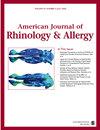A New Patient-reported Outcomes Measure for Surgically Treated Epiphora: Tearing Assessment and Rating Scale-12 (TEARS-12)
IF 2.5
3区 医学
Q1 OTORHINOLARYNGOLOGY
引用次数: 0
Abstract
BackgroundNo widely accepted, validated instrument currently exists to measure clinical outcomes in patients who undergo dacryocystorhinostomy (DCR) for treatment of epiphora.ObjectiveTo develop a patient-reported outcome measure applicable to this population.MethodsPsychometric evaluations, consultation with experts, and review of the literature informed item generation of a 12-question questionnaire to incorporate the most relevant symptoms experienced by patients with nasolacrimal duct obstruction. This questionnaire, known as the Tearing Assessment and Rating Scale-12 (TEARS-12), was administered to 32 patients before and after intervention, in the form of endoscopic DCR. Statistical analysis was performed to measure internal consistency, responsiveness, and test-retest reliability.ResultsPre-operative and post-operative TEARS-12 scores (28.2 [standard error (SE) 3.19] vs 11.8 [SE 3.25], respectively, P = 0.001) demonstrated improved patient outcome within 6 weeks following endoscopic DCR. Cronbach's alpha for the questionnaire was 0.90, indicating high overall reliability. Additionally, each question demonstrated internal reliability, with a corrected item-total correlation greater than 0.30. The intraclass correlation between the two pre-operative scores was 0.858 ( P < 0.001), indicating high test-retest reliability.ConclusionTEARS-12 is a statistically valid, easy-to-administer instrument to measure clinical outcomes in patients who undergo endoscopic DCR.针对手术治疗后眼睑外翻的新患者报告结果测量法:撕裂评估和评分量表-12(TEARS-12)
背景目前还没有一种广为接受的、经过验证的工具可用于测量接受泪囊鼻腔造口术(DCR)治疗眼外胀痛患者的临床结果。方法通过心理测量评估、咨询专家和查阅文献,制作了一份包含 12 个问题的调查问卷,将鼻泪管阻塞患者经历的最相关症状纳入其中。该问卷被称为 "撕裂评估和评分量表-12"(TEARS-12),在内窥镜 DCR 干预前后对 32 名患者进行了问卷调查。结果术前和术后 TEARS-12 评分(分别为 28.2 [标准误差 (SE) 3.19] vs 11.8 [标准误差 3.25],P = 0.001)显示,内窥镜 DCR 术后 6 周内患者的预后有所改善。问卷的 Cronbach's alpha 值为 0.90,表明总体可靠性很高。此外,每个问题都具有内部可靠性,校正后的项目-总相关性大于 0.30。TEARS-12是一种统计有效、易于管理的工具,可用于测量内镜下DCR患者的临床结果。
本文章由计算机程序翻译,如有差异,请以英文原文为准。
求助全文
约1分钟内获得全文
求助全文
来源期刊
CiteScore
5.60
自引率
11.50%
发文量
82
审稿时长
4-8 weeks
期刊介绍:
The American Journal of Rhinology & Allergy is a peer-reviewed, scientific publication committed to expanding knowledge and publishing the best clinical and basic research within the fields of Rhinology & Allergy. Its focus is to publish information which contributes to improved quality of care for patients with nasal and sinus disorders. Its primary readership consists of otolaryngologists, allergists, and plastic surgeons. Published material includes peer-reviewed original research, clinical trials, and review articles.

 求助内容:
求助内容: 应助结果提醒方式:
应助结果提醒方式:


